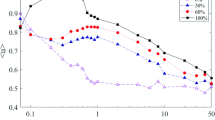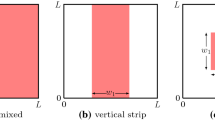Abstract
Segregation phase transition has long been considered a robust phenomenon in celebrated Schelling’s segregation model, the degree of segregation remains largely unchanged even with different underlying topologies. However, in this study, we have observed that a significant suppression of segregation can be achieved by modifying agents’ migration paths in a Schelling’s metapopulation model with a simple step utility function, based on an extremely heterogeneous star-type underlying complex network. We find that the degree of suppression is occupancy density dependent, and the effect is even more pronounced at higher occupancy densities. To explore the impact of this modification of migration paths, we suggest a random adding-link mechanism as well. We have observed that as the adding-link probability increases from zero to unity, the significantly suppressed segregation phase at lower probability eventually emerges. Moreover, we identified a scaling law of the average stationary interface density versus the re-scaled adding-link probability.
Graphic abstract





Similar content being viewed by others
Data availability statement
Data and source code associated in the manuscript are available upon request.
References
G. Bianconi, A. Arenas, J. Biamonte, L.D. Carr, B. Kahng, J. Kertesz, J. Kurths, L. Lü, C. Masoller, A.E. Motter, M. Perc, F. Radicchi, R. Ramaswamy, F.A. Rodrigues, M. Sales-Pardo, M.S. Miguel, S. Thurner, T. Yasseri, Complex systems in the spotlight: next steps after the 2021 nobel prize in physics. J. Phys.: Complex. 4(1), 010201 (2023)
C. Castellano, S. Fortunato, V. Loreto, Statistical physics of social dynamics. Rev. Mod. Phys. 81(2), 591–646 (2009)
M. Barthelemy, The statistical physics of cities. Nat. Rev. Phys. 1, 406–415 (2019)
M. Jusup, P. Holme, M. Kanazawa, K. Takayasu, I. Romić, Z. Wang, S. Gec̆ek, T. Lipić, B. Podobnik, L. Wang, W. Luo, T. Klanjs̆c̆ek, J. Fan, S. Boccaletti, M. Perc, Social physics. Phys. Rep. 948, 1–148 (2022)
T.C. Schelling, Dynamic models of segregation. J. Math. Soc. 1(2), 143–186 (1971)
T.C. Schelling, Micromotives and Macrobehavior (Norton, New York, 1978)
M.C. Cross, P.C. Hohenberg, Pattern formation outside of equilibrium. Rev. Mod. Phys. 65(3), 851–1112 (1993)
A.J. Laurie, N.K. Jaggi, Role of “vision’’ in neighbourhood racial segregation: a variant of the Schelling segregation model. Urban Stud. 40(13), 2687–2704 (2003)
W. Clark, M. Fossett, Understanding the social context of the Schelling segregation model. Proc. Natl. Acad. Sci. USA 105(11), 4109–4114 (2008)
M. Fossett, D.R. Dietrich, Effects of city size, shape, and form, and neighborhood size and shape in agent-based models of residential segregation: Are schelling-style preference effects robust? Environ. Plann. B. Plann. Des. 36(1), 149–169 (2009)
G. Fagiolo, M. Valente, N.J. Vriend, Segregation in networks. J. Econ. Behav. Organ. 64(3), 316–336 (2007)
R. Pancs, N.J. Vriend, Schelling’s spatial proximity model of segregation revisited. J. Public Econ. 91(1), 1–24 (2007)
S. Grauwin, F. Goffette-Nagot, P. Jensen, Dynamic models of residential segregation: an analytical solution. J. Public Econ. 96(1), 124–141 (2012)
M. Pollicott, H. Weiss, The dynamics of Schelling-type segregation models and a nonlinear graph Laplacian variational problem. Adv. Appl. Math. 27(1), 17–40 (2001)
S. Gerhold, L. Glebsky, C. Schneider, H. Weiss, B. Zimmermann, Computing the complexity for Schelling segregation models. Commun. Nonlinear Sci. Numer. Simulat. 13(10), 2236–2245 (2008)
R. Durrett, Y. Zhang, Exact solution for a metapopulation version of Schelling’s model. Proc. Natl. Acad. Sci. USA 111(39), 14036–14041 (2014)
D. Vinkovic, A. Kirman, A physical analogue of the Schelling model. Proc. Natl. Acad. Sci. USA 103(51), 19261–19265 (2006)
D. Stauffer, S. Solomon, Ising, Schelling and self-organising segregation. Eur. Phys. J. B 57(4), 473–479 (2007)
L. Gauvin, J. Vannimenus, J.-P. Nadal, Phase diagram of a Schelling segregation model. Eur. Phys. J. B 70(2), 293–304 (2009)
L. Gauvin, J.-P. Nadal, J. Vannimenus, Schelling segregation in an open city: a kinetically constrained blume-emery-griffiths spin-1 system. Phys. Rev. E 81, 066120 (2010)
T. Rogers, A.J. McKane, Jamming and pattern formation in models of segregation. Phys. Rev. E 85, 041136 (2012)
Y. Gandica, F. Gargiulo, T. Carletti, Can topology reshape segregation patterns? Chaos Soliton. Fract. 90, 46–54 (2016)
G. Su, Q. Xiong, Y. Zhang, Intriguing effects of underlying star topology in Schelling’s model with blocks. Phys. Rev. E 102, 012317 (2020)
N.G. Domic, E. Goles, S. Rica, Dynamics and complexity of the Schelling segregation model. Phys. Rev. E 83, 056111 (2011)
L. Dall’Asta, C. Castellano, M. Marsili, Statistical physics of the Schelling model of segregation. J. Stat. Mech.: Theory Exp. L07002, (2008)
S. Grauwin, E. Bertin, R. Lemoy, P. Jensen, Competition between collective and individual dynamics. Proc. Natl. Acad. Sci. USA 106(49), 20622–20626 (2009)
P. Jensen, T. Matreux, J. Cambe, H. Larralde, E. Bertin, Giant catalytic effect of altruists in Schelling’s segregation model. Phys. Rev. Lett. 120, 208301 (2018)
P. Erdős, A. Rényi, On random graphs. I. Publ. Math. (Debrecen) 6, 290–297 (1959)
Acknowledgements
The authors acknowledge the financial support of the National Natural Science Foundation of China via Grant No. 11505115.
Author information
Authors and Affiliations
Contributions
All the authors contributed equally to the analytical and numerical calculations contained in the present manuscript.
Corresponding authors
Rights and permissions
Springer Nature or its licensor (e.g. a society or other partner) holds exclusive rights to this article under a publishing agreement with the author(s) or other rightsholder(s); author self-archiving of the accepted manuscript version of this article is solely governed by the terms of such publishing agreement and applicable law.
About this article
Cite this article
Su, G., Zhang, Y. Significant suppression of segregation in Schelling’s metapopulation model with star-type underlying topology. Eur. Phys. J. B 96, 91 (2023). https://doi.org/10.1140/epjb/s10051-023-00560-9
Received:
Accepted:
Published:
DOI: https://doi.org/10.1140/epjb/s10051-023-00560-9




